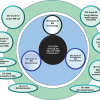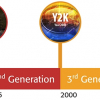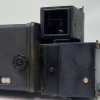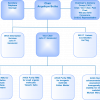Peter Jenksa and John Hammondb
aThe Jenks Partnership, Newhaven House, Junction Road, Alderbury, Salisbury, Wiltshire SP5 3AZ, UK
bStarna Scientific Ltd, 52–54 Fowler Road, Hainault Business Park, Hainault, Essex, IG6 3UT, UK
Back in 1956, John Osborne wrote his play “Look Back in Anger”, about a love triangle involving an intelligent and educated but disaffected young man of working-class origin, his upper-middle-class, impassive wife and her haughty best friend. The play, which went on to great success on the “silver screen”, gave rise to the phrase “angry young men” used to describe those who employed harsh realism in the theatre to contrast to the more escapist style of theatre in the early years of the 20th century.
In this edition of Quality Matters, I will look at the triangular relationship between ISO/IEC 17025, together with its parent the International Standards Organisation (ISO) and not forgetting the International Laboratory Accreditation Cooperation (ILAC), the Laboratory Accreditation Services that audit conformity and the laboratory quality manager (QM). In doing so, I wonder if we are building a generation of angry young QMs, who are comfortable in the structured, unforgiving and increasingly regimented world of quality in the 21st century, truly “angry young managers”!
We shall start at the very beginning: a long time ago, back in 1978 with the publication of ISO Guide 25. ISO Guide 25 set out a framework which advised on the procedures that might be used to accredit testing laboratories. Back then the PC and the internet were but a distant dream and the laboratory computer, if there was one, was a terminal to a mainframe! Indeed back in 1978, this paper was still set using linotype generated hot lead!
From 1978 ISO Guide 25 went through a number of iterations until in 1999 it was withdrawn with the release of ISO/IEC 17025. But ISO/IEC 17025 was much more than ISO Guide 25, it was the result of more than three years of work which had started with a simple revision to ISO Guide 25 but ended up being a total rethink, with input from many other sources including ILAC and others. There is a good overview of the transformation of ISO Guide 25 into ISO/IEC 17025 by Marie C. Walsh in Accred. Qual. Assur. 4(8), 365–368 (1999).
It was at this point that the relative virtues of “Guide” vs “Standard”, even now frequently debated in relation to the accreditation of Reference Material Producers now provided the regulatory shift from guidance to enforcement.
It may be thought that the biggest difference was that as a Standard it was prescriptive rather than an advisory Guide, but I would argue that there was a more significant change. For the very first time, the new standard clearly differentiated between Management requirements and Technical requirements in an analytical laboratory. Separating these functions made responsibilities clear and laid the foundation for a robust and properly managed quality system. The additional Technical requirement also differentiated it from the purely Quality Management standard requirements of ISO 9000.
Unfortunately ISO/IEC 17025:1999 did not have much of an impact as in parallel with the work to migrate ISO Guide 25 to ISO Standard 17025 work had been proceeding on a major revision of ISO 9000, this concluded with publication in 2000 of a new version that encompassed what were then thought to be radical changes in thinking by bringing the concept of process management to the fore. “Process management” can be defined as the monitoring and optimisation of an organisations activity, rather than simply inspecting the final product. ISO 9000:2000 also required the involvement of senior management so as to integrate quality into an organisation’s process system and in so doing stop delegation of quality functions to junior administrators. Another key objective was to improve effectiveness using clear performance metrics with numerical measurement of the effectiveness of tasks and activities. Finally, the standard made it very clear that continual process improvement and tracking customer satisfaction were a journey for the long haul.
ISO 9000 had been about for some time, although first published in 1987, 10 years after ISO Guide 25, it was based on the BS 5750 series of standards from the British Standards Institute (BSI). So its lineage goes back further to the publication of the United States Department of Defence MIL-Q-9858 Standard in 1959. Ten years later MIL-Q-9858 was revised into the NATO AQAP series of standards which in turn in 1974 were revised into the BS 5179 series of guidance standards and finally revised into the BS 5750 series of standards.
So in 2000, it was clear that there was considerable overlap between ISO/IEC 17025:1999 and ISO 9000:2000 but the wording was not always congruent. Accordingly, the ISO groups involved set to bring ISO/IEC 17025 into line with ISO 9000 so that wherever possible normative reference could be made to each standard with identical wording. This all took time and it was not until 2005 that the next version of ISO/IEC 17025 appeared. Most labs had adopted a “wait for the next version” approach, but from 2005 accreditation to the new Standard became the new dawn of Quality Management.
ISO/IEC 17025 was written in a general way and covers all types of laboratories including chemical, biological, environmental, materials and physical testing. Since the latest version was issued in 2005 it has been pulled in various directions and is now used by both testing laboratories and calibration laboratories. It has spawned “Enhanced Standards” such as the UK Environment Agency’s “MCERTS” that take method validation and performance to much higher levels than anticipated by the original ISO Working Group who created ISO/IEC 17025. The Standard has also been used, in partnership with ISO Guide 34, as the basis for the accreditation of certified reference materials producers and together with ISO Guide 43 and with input from ILAC, it became ISO Standard 17043 which is used to accredit providers of proficiency testing services.
The normal review cycle for ISO Standards should have resulted in a revision to ISO/IEC 17025 in 2010, but this was passed over, possibly because it was felt that change might slow the rapid adoption of the standard, and at that time no significant revision was required. However, three years later, quality initiatives in other areas once again may signal a quantum change in the requirements to update this standard?
Since 2005 ISO/IEC 17025 has spawned an industry with consultants, publishers and advisors all seeking to aid and support the increasingly pressured and angry QM.
We now approach, in 2015, the 10th anniversary of the issue of the standard: I understand that this time there will be a full review, so in about 2020 the third edition will appear. Work will start soon so it is important to think about what the users want.
It seems to me that ISO/IEC 17025 has become too big to be a single standard trying to cover many and varied purposes. As with ISO 9000, it needs to be split into a family of related standards, perhaps:
- 170251 for chemical analytical labs,
- bringing in MCERTs and cGMP type method and instrument validation
- 170252 for physical testing labs
- 170253 for calibration of measurement devices
This leaves the accreditation of CRM producers. It could be a good point to combine 170251 and ISO Guides 30 to 35 into a new ISO 17034 for the purpose, mirroring ISO 17043.
The revision of ISO/IEC 17025 will have profound global consequences: it is THE standard that ushered in the concept of “tested once, accepted everywhere”. The ability to really trust analysis conducted by a laboratory in another country has had a significant impact on global trade. So much so that since 2010 ILAC has organised and supported “World Accreditation Day”.
In 2013 WAD will have taken place on 9 June 2013, just as this edition of Spectroscopy Europe is printing. World Accreditation Day is a global initiative jointly established by the International Accreditation Forum ( IAF) and International Laboratory Accreditation Cooperation (ILAC) to raise awareness of the importance of accreditation-related activities. For 2013 the focus is on the important role accreditation plays in facilitating trade around the world, both within and across national borders.
My co-columnist John P. Hammond CSci CChem FRSC will be picking up this subject in a future edition of Spectroscopy Europe. John is one of the UK Delegates to ISO REMCO and although the revision of ISO/IEC 17025 is not managed by this technical committee it is certain that it will have a significant input into the procedure as has been mentioned above ISO/IEC 17025 works together with ISO Guide 34 as a means of accrediting producers of Certified Reference Materials.
Whatever happens to ISO/IEC 17025 the QM landscape of 2020 will be much more rigorous, with little room for manoeuvre or subjective assessment and the QM will certainly work at a sharper edge, a far cry from my early days in the chemical industry when Quality Management was a game played between “Production” and “Inspection” with on more than one occasion the same sample sent to QA testing irrespective of the batch manufactured.
What are your thoughts? Let John and me know, but more importantly, let your local standards body know.










